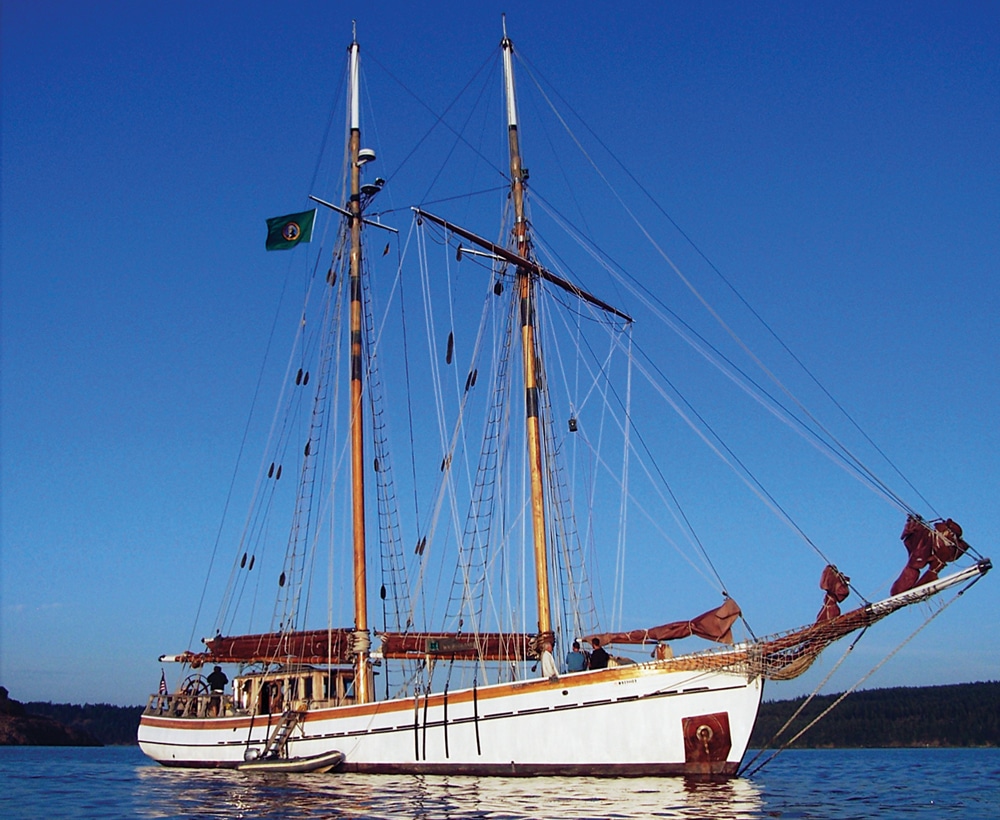
The Way It’s Supposed to Be: W.N. Ragland
Angels of the water,
sirens of the sea
Whispering their
sweet love songs
Calling out to me…
In the late ’60s, singer-songwriter Neil Young disbanded Buffalo Springfield, the rock group he had formed with Stephen Stills, and, at loose ends, hooked up again with Stills to join a fledgling group called Crosby, Stills & Nash, moving the ampersand and tacking his name on after it.
The rest is history.
Crosby, Stills, Nash & Young, known to the cognoscenti as CSNY and constantly embroiled in turmoil and interpersonal strife, remains a lasting influence on music and culture, in spite of the fact that its meteoric brilliance burned barely a year before it imploded. That the musicians were in the right place and time is evident because they were invited to an unknown music gathering, where they started their set by admitting “This is only the second time we’ve performed in front of people. We’re scared. …” That event is now known as Woodstock.
The wind and the sea had always drawn Canadian native Neil Young, so it was no surprise that, with his newfound wealth, he acquired a most unusual yacht. At a time when rock musicians were more likely to be partying aboard flashy, large motoryachts, Young chose a rustic 101-foot Baltic trading schooner.
Don’t try to rescue me
I’m gonna go with my ship…
A ship, indeed, but not a new one. Built in 1913 to haul granite through the rugged northern seas, she was 77 feet on deck and weighed a Rubenesque 280,000 pounds — 2.5 times the displacement of a similarly sized Swan yacht. As such, she’s much larger than Mayan, the 59-foot Alden schooner owned by Young’s CSNY singing partner, David Crosby. Young named her W.N. Ragland after his grandfather, and, for the next 35 years, he sailed far, wide and handsome aboard this pirate ship, lavishing care and maintenance upon her without regard to cost.
You cannot describe Ragland without using the words husky or rugged, but even such evocative words pale when you see the yacht up close. Launched before the opening of the Panama Canal and the First World War, Ragland comes from an era when such a vessel had to be seaworthy and self-reliant in every possible wind and sea condition. There was no Sea Tow to come fetch you when the winter gales howled down the Skagerrak off Scandinavia. There was no radio to call for help from a lee shore, and even the term Mayday, the international distress call, wouldn’t be coined for another decade.
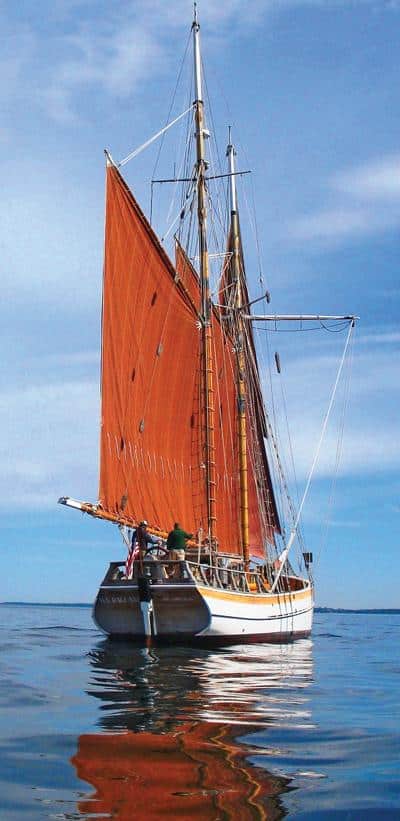
Wind blowing through my sails,
it feels like I’m gone
Leaving with the wind blowing
Through my sails…
When Young sailed away, Ragland was more than half a century old, and she needed work. Originally built of oak, she had closely spaced 6-by-6-inch (yes, inch!) ribs, but the topsides planking had taken a beating from years of hard toil. With royalties from the many successful CSNY albums and concerts, Young ordered a railroad car filled with 20,000 board feet of furniture-grade mahogany to replank the yacht.
Stand on her teak decks and you feel like you’re on a concrete sidewalk, because the quarter-sawn teak is as much as 4 inches thick! In an era when the wood veneering on modern yachts is paper-thin, Ragland is simply remarkable. The exterior teak is left to turn a pleasant silver, giving the decks, the enclosed pilothouse and the various rails and skylights a properly seaworthy glow. Maintenance is as straightforward as hosing the decks, using the high-pressure saltwater fire pump.
During Young’s time as the curator/owner of Ragland, he and his friends and family sailed the world, but she was loaned out for scientific expeditions as well. The political and ecological activist lent her to a marine-research organization for a two-year voyage to Hawaii and Alaska to study whales, and later, another crew of scientists sailed her to Hawaii with a cargo of nutrients to nourish a patch of ocean that they studied to look for a cure for global warming.
Though a previous reunion of CSNY had gone down in flames, the foursome couldn’t stay away from each other, and CSNY has produced several albums and concert tours in recent years. More impressive is Young’s long and flourishing solo career. Nevertheless, it was time for Ragland to find a new owner.
Young listed Ragland for sale with Walter Wallace of Wallace Yacht Co. in Port Townsend, Washington, not only because that was her home port, but also because Wallace has a passion for classic wooden yachts. Wallace found a buyer, but the deal fell through and Ragland languished in a yard while the attorneys fought it out.
Wallace, who owned both a 1926 65-foot tugboat plus a live-aboard trawler, couldn’t bear the thought of Ragland deteriorating and took it upon himself to haul the yacht and get her ready for listing again. When Young found out what Wallace had done, he was very appreciative and he also made an interesting suggestion.
“Why don’t you buy her?”
The offer startled Wallace, but he was hooked. He sold his two boats, bought Ragland, and moved aboard. At this point, he’s lived aboard for about three years, entertaining friends and family, sharing her with the public at wooden boat festivals, and even sailing in a few regattas.
And now Ragland is ready for her next benefactor. Wallace says she’s too nice “for just a dude and a dog,” referring to his Jack Russell terrier. “For me to go aboard and build a fire and watch TV and then go to work the next day, well, it just isn’t right. It’s a waste of a great boat!”
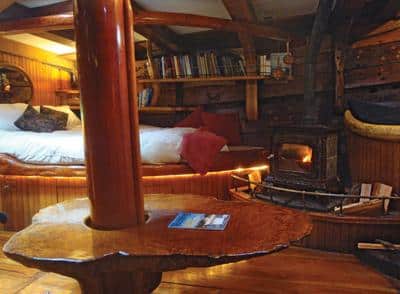
She’d be perfect for a family wanting to go cruising, or perhaps an organization since she is U.S. Coast Guard documented and grandfathered under the Jones Act for coastal trade. But Ragland isn’t your typical yacht. The interior of this floating home must be seen to be believed, because she is quite simply unlike any other yacht. She is Haight-Ashbury-hippie-pad-meets-Swiss-Family-Robinson-treehouse. She is wood and polished bronze and gleaming varnish and Turk’s head knots and a hearthstone fireplace and cozy nooks for curling up with a good book. And she is, um, eclectic.
To mention that she has actual elephant tusks wrapping around the edge of the berth and settee might give you an inkling — as would mentioning that the immense solid-wood coffee table in the salon is actually a flensing block on which old-time whalers once carved up blubber. Or that the huge redwood burl table in the owner’s stateroom is from Young’s California ranch and could be installed only when the mast was lifted out.
The interior was clearly arranged for space and comfort, and the owner’s suite occupies fully a third of the yacht, complete with a wood-burning fireplace, comfortable seating, a private head with shower and the aforementioned table wrapped around a mast the size of a tree trunk. Oh, yes, there’s a pipe organ at the forward end just in case you want to work out the lyrics for your own album.
The salon is a comfortable gathering place, with another redwood burl dining table facing across the 22-foot beam to a settee, with a snug pilot berth tucked behind an arched entry like the sleeping compartment on a vintage Pullman car.
The galley shouldn’t come as a surprise, because this is not a yacht that would suffer the usual Corian or granite countertops — no, this is a yacht for which solid pieces of longleaf yellow pine were used, covered with thick layers of resin. The cabin sole is just as unusual, because it is beautiful maple reclaimed from the Windsor Hotel ballroom floor in New York. This is a yacht that defines the word patina.
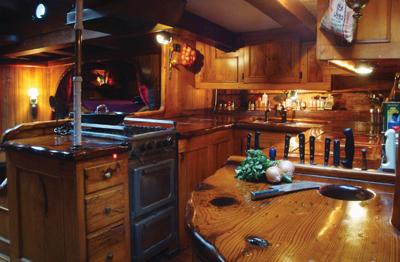
Three private guest cabins open into the salon from the corners, with two doubles to starboard and a single to port. Past the companionway to the pilothouse and into an alleyway, you’ll find the engine room, which, like the rest of the yacht, is immaculate.
In fact, I had been braced for that gamy aroma of old yacht when I first climbed down the companion stairs, but she is absolutely sweet and unscented. None of the usual eau de diesel mixed with parfum de moldy cushions and accented with cologne de spongy wood. No, one look in the bilge shows that Ragland is as tight and dry as the day before she was launched.
Now that we’re in the engine room, it’s worth taking a peek under the hulking 350-horsepower Cat 3406 TA, and all you might see is a little dust in the pan. No oil, no grease, no drips. That big piece of iron will shove Ragland along at up to nine knots for about 2,000 miles and, with her immense 44-inch four-bladed prop, she could probably power straight up Niagara Falls. Two Northern Lights 12 kW gensets are in sound boxes and accessible; a full workbench is above the engine, and, should you need to lift anything really heavy, there is a 2.5-ton (ton!) chain hoist that runs on an immense I-beam track over the engine. Nothing wimpy about this yacht! Other goodies in the engine room include a commercial-size Craftsman tool chest and Poseidon dive-tank compressors. Filling the after portion of the hull is the captain’s cabin, with a king-size berth, settee and desk.
Moving around on Ragland‘s deck is easy with high solid bulwarks and teak rails. Forward of the pilothouse and between the masts are the two bronze-grated skylights that bring light to the salon, but the one thing that will stop you in your tracks is the large bronze cowl vent that has an equally large bronze octopus draped comfortably over it. It’s just one of the many things about Ragland that will make you grin.
Up on the foredeck is another uniquely Ragland feature: the hydraulic anchor windlass from a German U-boat. What can you say? Wallace has added a hydraulic winch at the base of the main mast that raises sails, runs crew aloft in a bosun’s chair and can offload tenders and gear as well.
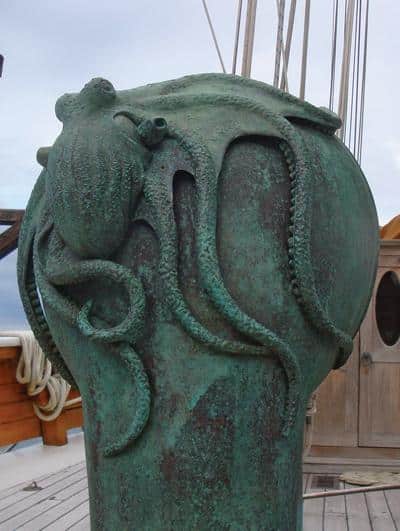
Technically, Ragland is a topsail schooner, with an athwartship yard on the foremast for broad reaching and running offshore. In keeping with her looks, her sails are all tanbark-colored, and she has traditional gaff-headed main and foresail as well as a flying jib and jib off the bowsprit, plus a forestaysail on a self-tacking boom.
Under way, Ragland fairly reeks of tradition. Experienced skippers know that she’s meant to go offshore; landlubbers think she’s a square-rigger, and children know she’s really a pirate ship. I think she’s quite wonderful.
It’s easy to see that Walter Wallace, like Neil Young before him, is torn about parting with her. Even spending a few hours aboard is infectious, and it’s almost too easy to fall in love with this eclectic and remarkable vessel.
Wooden ships on the water,
very free and easy,
Easy, you know, the way it’s
supposed to be…
LOA: 101’0″
Beam: 22’0″
Draft: 9’0″
Displ.: 140 tons
Fuel: 1,800 gal.
Engine: 1 x 350-hp Caterpillar 3406 TA diesel
Current Asking Price: $600,000
For more details on the W.N. Ragland, contact the broker/owner, Wallace Yacht Co., 877-305-9828; www.wallaceyachts.com.









